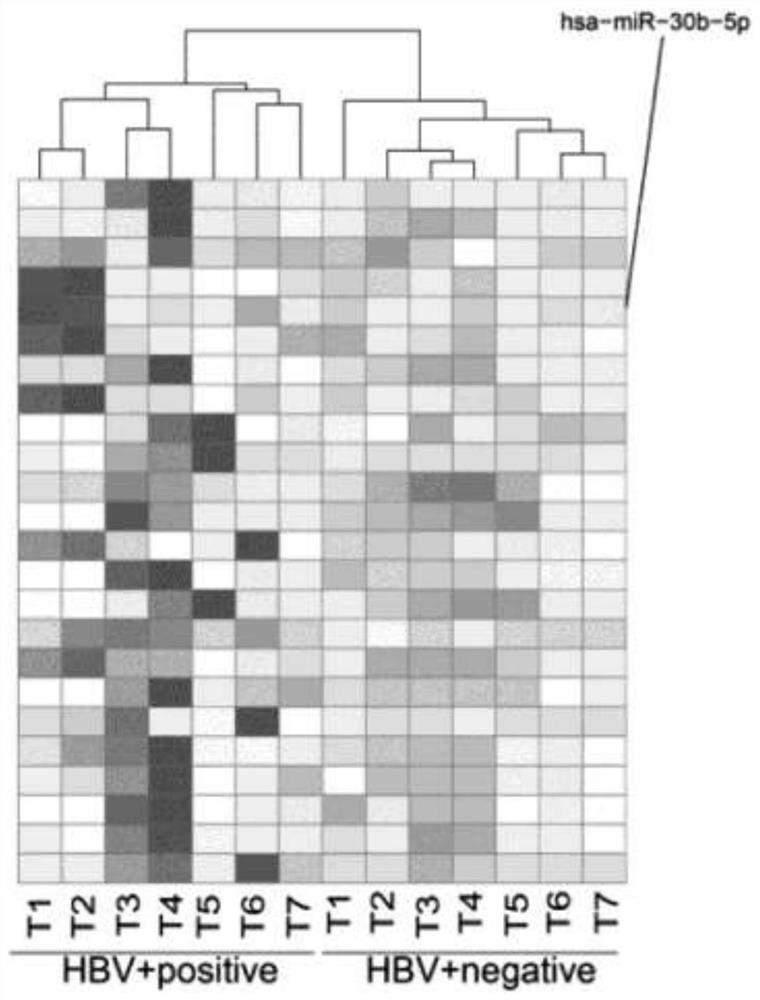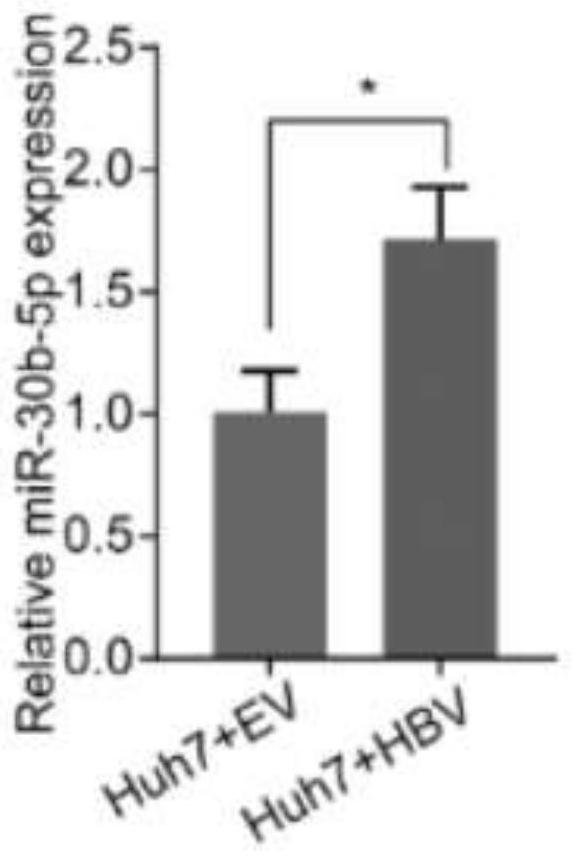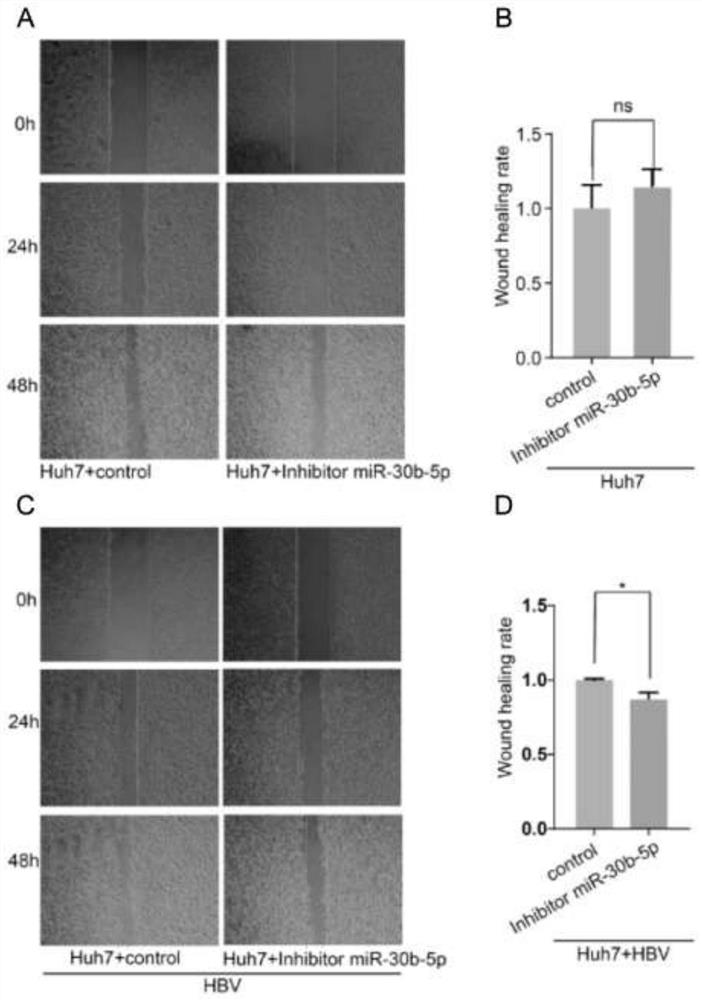Use of micromolecule RNA-30b-5p as target molecule
A mir-30b-5p, target gene technology, applied in medical preparations containing active ingredients, pharmaceutical formulations, anti-tumor drugs, etc. Growth and Invasion, Reduced Growth and Invasion Ability, and Inhibition of Hepatoma Cell Proliferation
- Summary
- Abstract
- Description
- Claims
- Application Information
AI Technical Summary
Problems solved by technology
Method used
Image
Examples
Embodiment 1
[0037] Example 1: Analysis of the difference in transcription level of miR-30b-5p in HBV-related or non-HBV-related hepatocellular carcinoma tissues
[0038] Add Trizol reagent (1 mL per 100 mg of tissue) to the tumor tissues of 7 patients with liver cancer in the experimental group and 7 control groups obtained through surgical resection, grind with an electric homogenizer, and let stand for 5 minutes after completion. Chloroform was added to the tissue homogenate (200 μL per 100 mg of tissue homogenate), shaken vigorously and left to stand for 5 minutes, then centrifuged at 4° C. for 15 minutes (12000 rpm). After centrifugation, transfer the aqueous phase of the layered liquid to another centrifuge tube, add an equal volume of isopropanol and mix well, and let stand at room temperature for 20-30 minutes. Centrifuge again for 10 minutes, discard the supernatant, a white precipitate can be seen at the bottom of the tube, and put the centrifuge tube into an ultra-clean bench to...
Embodiment 2
[0044] Example 2: Inhibiting the level of miR-30b-5p in HBV-related liver cancer cells can inhibit the growth and invasion of tumor cells
[0045] In this example, the inventors first selected a non-HBV-related liver cancer cell line Huh7, and compared the effect of miR-30b-5p on cell growth and invasion ability when infected with or not infected with HBV by scratch test. The miR-30b-5p-specific siRNA was transfected into Huh7 cells or Huh7 cells infected with HBV, and compared with Huh7 cells, respectively. 24 h after transfection, the cell culture dish was scratched with a pipette tip and washed twice with PBS to remove scraped cells. The cells were observed and photographed at 0h, 24h and 48h after the scratch, and the migration area and migration rate of the cells on both sides of the scratch were analyzed and calculated using Image J software. The results are as follows image 3 shown. It can be seen that the distance between cells on both sides of the scratch between t...
Embodiment 3
[0048] Example 3: Inhibition of miR-30b-5p in animal models can inhibit tumor growth
[0049] In this example, miR-30b-5p-specific siRNA was transfected into Hep3B cells, and Hep3B cells were used as a control group. Description: Hep3B is a human liver cancer cell line that has integrated a complete HBV genome, and HBV virus particles can be detected in the supernatant during its growth and proliferation.
[0050] Cells were collected after transfection and resuspended in serum-free DMEM medium to adjust the cell concentration to 2×10 7 cell / mL. The same amount of Hep3B cells and the Hep3B cells transfected with the above siRNA were inoculated subcutaneously into nude mice with a syringe, and three mice were inoculated in each group. After inoculation, the growth of the tumor was observed and the size of the tumor was recorded. The above-mentioned mice were sacrificed 26 weeks after the inoculation, and the size of the tumor was measured after peeling off and photographed fo...
PUM
 Login to View More
Login to View More Abstract
Description
Claims
Application Information
 Login to View More
Login to View More - R&D
- Intellectual Property
- Life Sciences
- Materials
- Tech Scout
- Unparalleled Data Quality
- Higher Quality Content
- 60% Fewer Hallucinations
Browse by: Latest US Patents, China's latest patents, Technical Efficacy Thesaurus, Application Domain, Technology Topic, Popular Technical Reports.
© 2025 PatSnap. All rights reserved.Legal|Privacy policy|Modern Slavery Act Transparency Statement|Sitemap|About US| Contact US: help@patsnap.com



